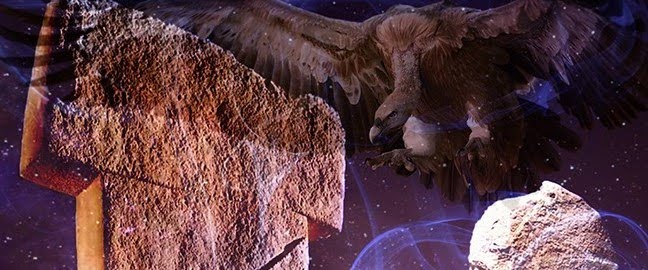Göbekli
Tepe, discovered in south-eastern Turkey in 1994, has been dubbed the oldest
temple in the world. Its earliest phase comprises a series of oval-shaped stone
buildings built on a prominent hill in the vast Harran Plain. They date to
c9600BC.
There is no evidence for the worship
of any deity here; rather it may be a hilltop ‘sanctuary’ linked to a shamanic
tradition. Huge feastings took place here, and the buildings may have been used
for initiation ceremonies or rituals to ensure the well-being of the huge
number of people connected with the site.
Each enclosure contains an array of
T-shaped stone pillars set into the outer wall and another pair of pillars
standing side by side in the centre. These pillars, up to six metres in height
and weighing 15 tonnes, are carved with lions, boars, foxes, vultures, snakes,
wild cattle and many other predatory or dangerous creatures once found in the
area. At least some pillars were hung with ochre-painted human skulls which
looked down upon the viewers.
To enter the buildings,
one had to crawl or slide through small stone portals carved with snakes, boars
and other deadly creatures. The towering pillars would create a near terrifying
sense of power and claustrophobia, increased by the predatory creatures
creeping from the stone all around, perhaps enhanced by hallucinatory or
shamanic plants. The whole feel of Göbekli Tepe
is macabre and unsettling.
It seems a place which had to be
endured, which would grant the successful person entrance to adulthood;
initiation as a shaman; bonds with the spirit world; or bonds with the animals
which gifted their prowess as hunters and their bodies as prey. A place where a
person was seen, tested and potentially accepted by the spirit world and its
emissaries so that their success in the physical world could become reality.
Reconstruction of Göbekli Tepe in Şanliurfa
Museum
It has been suggested by both
archaeologists and alternative researchers that Göbekli Tepe
is the real-life inspiration for Duku, the mythical mound of creation in Middle
Eastern mythology. Duku, meaning ‘holy mound’, was the home of the Gods and the
place where civilisation was created, an eerie resonance with what
archaeologists have discovered about the earliest known civilisation which
centred on Göbekli Tepe. And Göbekli Tepe, intriguingly, translates to ‘the hill of the
navel’: the place where the world linked to its creator.
The view from the site
I’ve named Göbekli Tepe as Duku in Broken Skies. As the archaeology
suggests, it is the most important site for the Irin shamans, and
directly links to the slow recovery of the world after its impact with a comet.
The individual characteristics and nature of each building and its decorated
pillars will be discussed in coming posts.
























